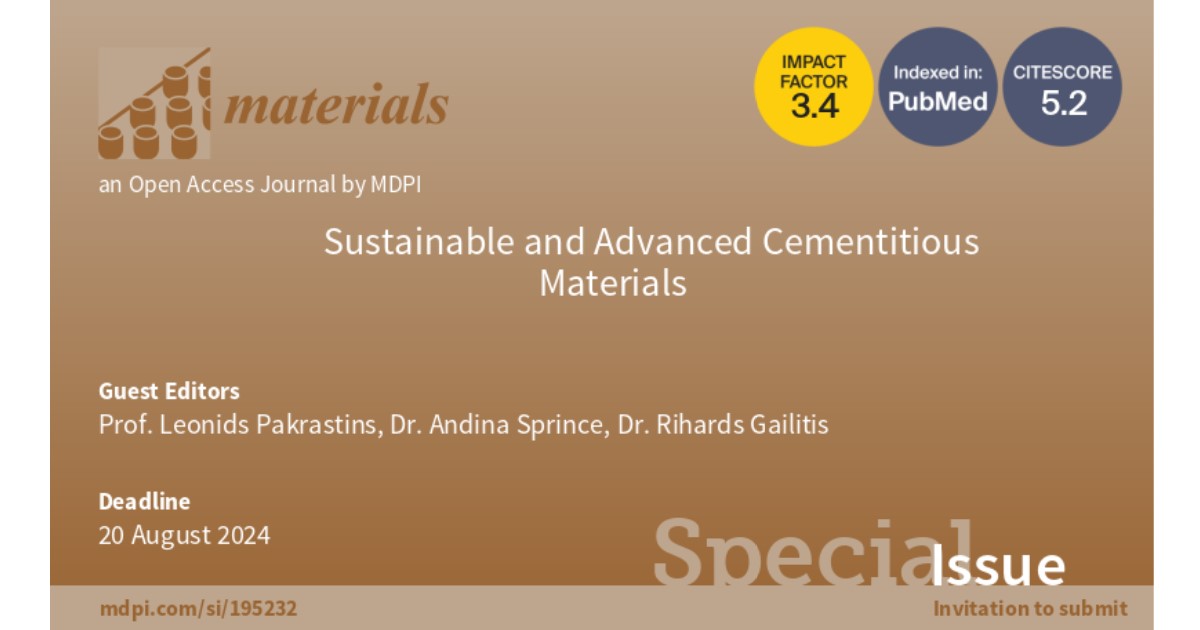Sustainable and Advanced Cementitious Materials
A special issue of Materials (ISSN 1996-1944). This special issue belongs to the section "Construction and Building Materials".
Deadline for manuscript submissions: 20 August 2024 | Viewed by 2180

Special Issue Editors
Interests: long-term properties of cementitious materials; structural health monitoring; reinforced concrete structure design; Eurocode adaption in country building regulations
Interests: innovative concrete and cement composite materials; geopolymer concrete; foamed composite; long-term properties of concrete composites in various stress-strain conditions; physicomechanical properties
Interests: long-term properties of cementitious materials; long-term properties of fiber reinforced cementitious materials; 3D printed cementitious material long-term properties; foamed cementitious composite mechanical and long-term properties
Special Issue Information
Dear Colleagues,
Recently, CO2 emission reduction, as well as building waste reduction and recycling, have been key topics for legislative bodies around the globe. In addition to these issues, new restrictions have been imposed. As the construction industry is one of the most polluting industries, the restrictions, which mostly refer to CO2 reduction of the construction material manufacturing and building processes, have given rise to the need for optimized construction materials and optimized building processes in order to achieve or come close to achieving this goal. As concrete and other cementitious composites are the backbone of modern civil and industrial infrastructures, there is no way to reduce CO2 by abandoning cementitious material usage altogether. Nevertheless, one proposed way is to optimize cementitious material design and to incorporate construction and building waste into the construction materials and their compositions.
Therefore, the goal for this Special Issue of Materials is to attract original contributions, with topics related to the latest developments in sustainable and innovative cementitious materials, as well as their design and property assessments.
Prof. Dr. Leonids Pakrastins
Dr. Andina Sprince
Dr. Rihards Gailitis
Guest Editors
Manuscript Submission Information
Manuscripts should be submitted online at www.mdpi.com by registering and logging in to this website. Once you are registered, click here to go to the submission form. Manuscripts can be submitted until the deadline. All submissions that pass pre-check are peer-reviewed. Accepted papers will be published continuously in the journal (as soon as accepted) and will be listed together on the special issue website. Research articles, review articles as well as short communications are invited. For planned papers, a title and short abstract (about 100 words) can be sent to the Editorial Office for announcement on this website.
Submitted manuscripts should not have been published previously, nor be under consideration for publication elsewhere (except conference proceedings papers). All manuscripts are thoroughly refereed through a single-blind peer-review process. A guide for authors and other relevant information for submission of manuscripts is available on the Instructions for Authors page. Materials is an international peer-reviewed open access semimonthly journal published by MDPI.
Please visit the Instructions for Authors page before submitting a manuscript. The Article Processing Charge (APC) for publication in this open access journal is 2600 CHF (Swiss Francs). Submitted papers should be well formatted and use good English. Authors may use MDPI's English editing service prior to publication or during author revisions.
Keywords
- modern cementitious materials
- sustainable development
- innovative construction materials








